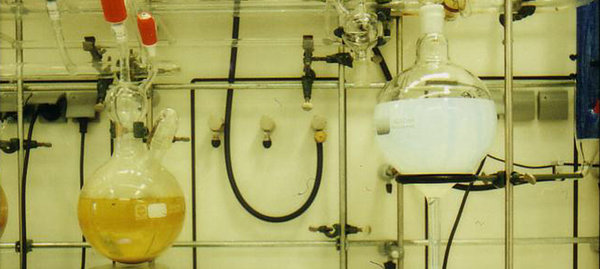
Special Equipment
General Overview
There is a number of instruments for measuring the static and dynamic surface and interfacial tension of solutions, spanning over a large time interval from less than 1 ms up to several h:
- Ring tensiometer TD1
- Automatic Ring Tensiometer TE2
- Drop Volume Tensiometer TVT2
- Bubble Pressure Tensiometer MPT2, BPA-1P
- Pendent/Sessile Drop Method PAT1, PAT2-USB
- Drop Pressure Method DPA1
Investigations of the interfacial dilational and shear rheology are performed with the following methods:
- transient relaxations with the pendent drop or drop pressure set-up
- higher frequency harmonic oscillations with the oscillating/drop/bubble apparatus
- low frequency harmonic damped shear oscillations with the interfacial shear rheometer
- higher frequency forced shear oscillations with the interfacial shear rheometer
To study the dilational rheology of interfacial layers a series of instruments, essentially designed at the MPI, are used. The reason for the variety of instruments is the need to cover a broad frequency range, i.e. to be able to identify characteristic times of various relaxation processes. For slow oscillation experiments we use the drop and bubble shape technique, which allows measurements from 0.001 to 1 Hz. Also the oscillating barrier method works in this time range. Experiments at frequencies up to 200 Hz and above can be performed with the oscillating drop/bubble method. The application of the capillary wave method gives access even to frequencies up to about 1000 Hz. The advantage of the drop/bubble methods is that they are applicable also to liquid/liquid interfaces.
For studies of the shear rheology we have a torsion shear rheometer ISR 1 which allows studies at the liquid/air and liquid/liquid interface. It is designed such that very low shear viscosities can be measured, however, it does not work for standard surfactant solutions (too small viscosities). Equipped with a Langmuir trough, it can be used also for studies of spread layers. Variation of the frequency (around 0.1 Hz) is possible by using different torsion wires. Forced shear oscillations at higher frequencies at the liquid/air and liquid/liquid interface can be performend with a sensitive commercial rheometer (Paar-Physica) equipt with the biconical disk interfacial cell geometry.
Other techniques used for the studies are a capillary viscosimeter from Lauda for the measurement of bulk viscosity, the ellipsometer from Optrel for measurements of the surface layer thickness, and the Brewster Angle Microscope from Optrel for studies of monolayer structures.
For the quantitative analysis of the interaction between two drops or two bubbles or even between a single drop with a single bubble in a liquid medium a drop and bubble micro manipulator is used. This experimental technique gives access to the coalecence behaviour of two single bubbles and drops as model for foams and emulsions. Studies with concentric droplets are used as model for multiple emulsions.
|
Force Methods Tensiometer (TD1 from LAUDA)
|
S. Siegmund
|
|
Drop Volume Tensiometer (TVT 2 from LAUDA)
|
S. Siegmund
|
|
Interfacial Shear Rheometer (ISR 1 (torsion pendulum technique) from SINTERFACE)
|
J. Krägel
|
|
Interfacial Shear Rheometer (MCR 301 - IRS from Anton-Paar)
|
J. Krägel
|
|
Viscosity Measuring System (PVS 1 from LAUDA)
|
J. Krägel
|
| Thin Film Analyser (FA 1 from SINTERFACE) |
G. Gochev
|
|
Multiscope and Brewster Angle Microscope (from OPTREL)
|
G. Gochev
|
|
Automatic Ring Tensiometer (TE 2 C and TE 3 C from LAUDA)
|
S. Siegmund
|
|
Maximum Bubble Pressure Tensiometer (BPA 1P from SINTERFACE)
|
S. Siegmund
|
|
J. Krägel
|
|
|
Oscillating Drop/Bubble Rheometer (ODBA 1 from SINTERFACE)
|
J. Krägel
|
|
Drop Pressure Analyser (DPA 1 from SINTERFACE)
|
J. Krägel
|
|
Capillary Pressure Tensiometer (DPA1 from SINTERFACE)
|
J. Krägel
|
|
Drop and Bubble Micro Manipulator (DBMM 1 from SINTERFACE)
|
J. Krägel
|